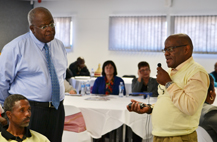Prof. Jansen meets the community
 |
|
Prof. Jansen listens attentively to Mr Teboho Moloi, who represented the Harrismith Business Forum at the community meeting where the UFS vision was shared.
Photo: Thabo Kessah
16 May 2012
|
We are very proud of our academic achievements, but without the human element, these achievements are not worth anything. This is according to Prof. Jonathan Jansen, Vice-Chancellor and Rector, who attended a meeting with the Thabo Mofutsanyana community in the Eastern Free State.
Prof. Jansen made the community aware that the university has two very important and interlinked projects – the academic and human projects.
“Our university has ambitions to produce the best scholars in various fields, but this cannot be done if we neglect the human aspect of doing things in the right way. We want to produce academic giants as much as we want to produce graduates of life,” said Prof. Jansen to an audience that included representatives from the traditional councils, business, religious and farming communities as well as the Maluti-A-Phofung and Dihlabeng Local Municipalities.
Prof. Jansen said that the memorandum of understanding that the university signed with the Dihlabeng Local Municipality in 2010 was already yielding positive results.
“There has been an enormous improvement in the matric results of the Dihlabeng schools that are part of our efforts to contribute towards building a brighter future for our children. We want to thank the municipality and the Honourable Mayor Tjhetane Mofokeng for being part of this partnership,” added Prof. Jansen.
“We are grateful that the university is considerate of its stakeholders in developing this Maluti-A-Phofung area. I am also aware that this institution has contributed towards the building of a crèche in the Mabolela village in Qwaqwa and for this we are very happy,” said Ms Linah Mnisi from Motlotlwane Projects and Consultants.